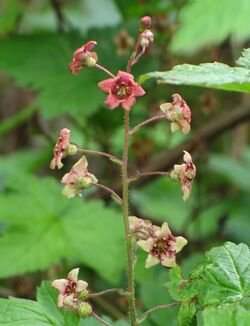Biology:Ribes laxiflorum
| Ribes laxiflorum | |
|---|---|

| |
| R. laxiflorum specimen from Joffre Lakes Provincial Park, British Columbia | |
| Scientific classification | |
| Kingdom: | Plantae |
| Clade: | Tracheophytes |
| Clade: | Angiosperms |
| Clade: | Eudicots |
| Order: | Saxifragales |
| Family: | Grossulariaceae |
| Genus: | Ribes |
| Species: | R. laxiflorum
|
| Binomial name | |
| Ribes laxiflorum | |
| Synonyms | |
|
Ribes affine Douglas ex Bong. Ribes altamirani Jancz. | |
Ribes laxiflorum is a species of currant known by the common names trailing black currant, and spreading currant.[1] It is native to western North America.
Description
Ribes laxiflorum is a spreading, trailing shrub usually growing .5–1 metre (1 1⁄2–3 1⁄2 feet) in height. It has been known to take a somewhat vine-like form in appropriate shady habitat with nearby supports, climbing to 7 m (23 ft) in length.[2] It has fuzzy, glandular stems lacking spines and prickles. The hairy, glandular, maple-shaped leaves are up to 10 centimetres (4 inches) long and deeply divided into several pointed lobes lined with dull teeth. The inflorescence is a mostly erect raceme of up to eight flowers. The distinctive flower has five greenish, purplish, or red sepals which are often curved back at the tips. At the center is a corolla of five red or pink petals each measuring 1 millimetre (1⁄32 in) long, narrow at the base and wider or club-shaped at the tip. Inside the corolla are five red stamens tipped with whitish anthers. The fruit is a purple-black berry measuring 4–14 mm (3⁄16–9⁄16 in) wide which is waxy, hairy, or bristly in texture.[2]
Distribution and habitat
It is native to western North America from Alaska and Yukon south as far as northern California and New Mexico;[3] it has also been found in Siberia. Its habitat includes moist mountain forests, open clearings, streambanks, and the borders of mountain roads.
Uses
The berries are eaten locally (variously fresh, boiled, or as preserves) by Bella Coola, Haisla, Hanaksiala, Hesquiat, Kwakiutl, Lummi, Makah, Oweekeno, Skagit, and Tanana peoples.[4]
Other traditions use R. laxiflorum for an infusion to make an eyewash (roots and or branches, by the Bella Coolah).[4]
Decoctions of: bark to remedy tuberculosis (with the roots, by the Skokomish); or for the common cold (Skagit): leaves and twigs, as a general tonic (Lummi).[4]
Woody stems are fashioned into pipe stems (Hesquiat).[4]
References
- ↑ Jump up to: 1.0 1.1 1.2 Flora Americae Septentrionalis; or, a Systematic Arrangement and Description of the Plants of North America 2:731. 1813–1814 {{citation | mode = cs1 | title = Ribes laxiflorum | work = Germplasm Resources Information Network (GRIN) | url = | publisher = [[Organization:Agricultural Research ServAgricultural Research Service (ARS), United States Department of Agriculture (USDA) | access-date = July 20, 2010 }}
- ↑ Jump up to: 2.0 2.1 Flora of North America, Ribes laxiflorum Pursh, 1813. Trailing black or spreading currant
- ↑ Biota of North America Program 2014 state-level distribution map
- ↑ Jump up to: 4.0 4.1 4.2 4.3 Dan Moerman. "Search for Ribes laxiflorum". Native American Ethnobotany Database. Dearborn, Michigan: University of Michigan. http://herb.umd.umich.edu/herb/search.pl?searchstring=Ribes%20laxiflorum. Retrieved July 20, 2010.
External links
Wikidata ☰ Q7322348 entry
 |

